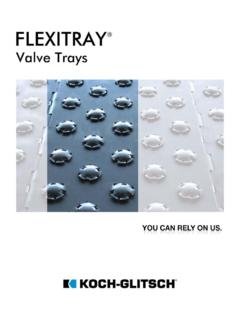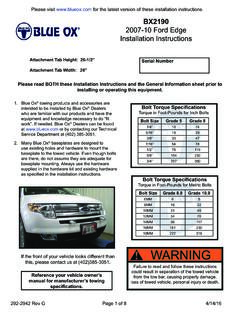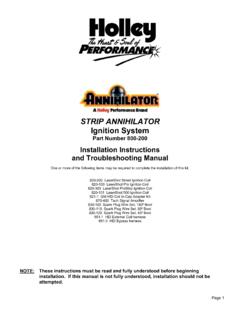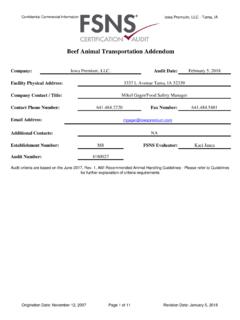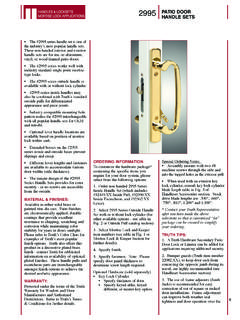Transcription of MAINTENANCE AND OPERATION MANUAL TYPE …
1 BOX 718 1927 HWY 90 WEST JENNINGS, LA 70546 P F " Q U A L I T Y C R E A T E S T R U S T " MAINTENANCE AND OPERATION MANUAL TYPE QFC GATE VALVES DISCLAIMER Any recommendations for use, oral or written, shall be considered advisory in content and as such, Quality Oil Tools, Inc. shall not be held liable under any warranty, expressed or implied, should this product not perform under conditions other than its intended use as a fluid gate valve device. Quality Oil Tools, Inc. shall in no way be liable for damages incurred while using this product. PRECAUTIONS This product is designed for use under high pressure conditions, and as such, extreme caution should always be taken when servicing, operating or testing this equipment Never attempt to disassemble a gate valve assembly until all pressure has been released from the body cavity.
2 Always be sure when pressure testing any product that all air has been purged from the system. Do not approach any equipment for visual inspection until a suitable pressure stabilization period has been allowed. Always use suitable protective equipment when performing any MAINTENANCE or testing. Always use caution when servicing this equipment as the retained fluid may present a H2S gas hazard. 2 INTRODUCTION The QFC Type Gate Valve is a full-bore through conduit non-rising stem gate valve. It is designed and manufactured in accordance with American Petroleum Institute-API-6A, NACE MR-01-75 for H2S Service, and all applicable industry standards at the time of manufacture. As with any pressure containing equipment, the Type QFC Gate Valve is subject to wear and eventual failure. Periodic disassembly and inspection is required and should be left to a qualified technician.
3 Every precaution has been taken to ensure that the highest quality product has been provided for use. Any question or correspondence should be directed to: Quality Oil Tools, Inc. P. O. Box 718 Jennings, Louisiana 70546 Telephone: (337) 616-3300 Fax: (337) 616-3299 E-mail: 3 Table of Contents Page I. Periodic MAINTENANCE 5 A. Lubrication 5 B. Lubrication Chart 5 C. Body Cavity Lubrication 6 D. Thrust Bearing Lubrication 6 II. Bonnet Grease Fitting Replacement 7 A. Valves 5,000 psi Working Pressure and Below 7 B. Valves 10,000 psi Working Pressure and Above 8 III. Stem Shear Pin and Thrust Bearing Replacement 8 A. Removal of Thrust Bearing 8 B. Installation of New Thrust Bearing 9 IV. Stem Packing Replacement with Pressure in Valve 10 A. Removal of Stem Packing 10 B. Installation of New Packing 12 V.
4 Gate and Seat Replacement 13 A. Gate and Seat Disassembly MANUAL Valve 13 B. Gate and Seat Assembly MANUAL Valve 13 C. Gate and Seat Disassembly Hydraulically Actuated 15 D. Gate and Seat Assembly Hydraulically Actuated 15 VI. Hydraulic Piston and Cylinder 17 A. Disassembly of Hydraulic Piston and Cylinder Assembly 17 B. Assembly of Hydraulic Piston and Cylinder Assembly 18 VII. Troubleshooting 20 Valve Diagram- MANUAL 21 Valve Diagram-Hydraulically Actuated 22 4 I. PERIODIC MAINTENANCE A. Lubrication For normal OPERATION (-20 F to 250 F) use Chemola Desco 960 or equivalent in the body cavity and stem bearing cap. For continuous service below 0 F use low temperature grease such as arctic grease LL1600A or equivalent in the body cavity and stem bearing cap. These grease formulations are available from: Quality Oil Tools, Inc. P. O. Box 718 Jennings, Louisiana 70546 Telephone: (337) 616-3300 Fax: (337) 616-3299 E-mail: B.
5 Lubrication Chart Bore Size (in) Pressure Rating Lubricant Weight (lb.) 2-1/16 All 2-9/16 To 10,000 2-9/16 15,000 3-1/16 To 10,000 3-1/16 15,000 4-1/16 To 5,000 4-1/16 10,000 5-1/8 5,000 5-1/8 10,000 5 C. Body Cavity Lubrication Normal Operating Conditions Quality Oil Tools, Inc., recommends lubricating gate valves during assembly. When the gate valve has been in service for one month, ten (10) operating cycles (one cycle equals opening and closing the valve one time), or is removed from service, the body cavity should be lubricated as follows: 1. Remove the grease fitting cap located on the bonnet flange outside diameter. 2. Using either a bucket-type or handheld grease gun, connect it to the grease fitting. 3. Pump an appropriate amount of lubricant into the body cavity (see Lubrication Chart in Item B above). Unusual Temporary Operating Conditions If the valve has been subjected to cementing or acidizing through the bore, the following procedure should be performed: 1.
6 Lubricate the valve body prior to placing it into service. 2. Flush the valve with an appropriate neutralizing fluid after it is removed from service. 3. Operate the valve with fresh water or an appropriate neutralizing fluid in the line. 4. Lubricate the valve cavity. D. Thrust Bearing Lubrication Lubricate thrust bearings once a month or as often as required to ensure smooth OPERATION . 1. Connect the grease gun coupler to the grease fitting on the bearing cap. 2. Pump lubricant into the fitting until grease runs out of the bleed hole on the opposite side of the bearing cap under the O-ring trash seal. 6 II. BONNET GREASE FITTING REPLACEMENT A. Valves 5,000 psi Working Pressure and Below 1. Backseat the valve. a. Completely close the valve. b. Loosen the bearing cap four complete counterclockwise turns using a 24 pipe wrench. c. Turn the hand wheel clockwise (closing direction) until the gate firmly contacts the cavity bottom and the stem moves outward, contacting the internal backseat shoulder.
7 D. Bump the hand wheel clockwise. 2. Test the effectiveness of the backseat. a. Remove the cap on the grease fitting. b. Trip the ball in the grease fitting check valve by inserting a 1/8 diameter by 3/4 long pin into the run of the fitting. c. Replace the grease cap and slowly turn it until the ball in the fitting is unseated and the backseating pressure is released. d. If pressure escapes quickly then stops, the backseat is effective. Proceed to step 3. e. If pressure continues to escape, the backseat is ineffective. Repeat steps 1 and 2. If the backseat will not seal then the grease fitting cannot be changed without isolating and removing all pressure from the valve. 3. Remove the grease fitting from the valve bonnet. 4. Install a new grease fitting. 7 B. Valves 10,000 psi Working Pressure and Above Note: These valves have a check valve beneath the bonnet grease fitting. 1. Remove the grease fitting cap. 2. Trip the ball into the grease fitting check valve by inserting a 1/8 diameter by 3/4" long pin into the run of the fitting.
8 3. Replace the grease cap and slowly turn it until it is unseated by the pin. 4. If pressure escapes quickly then stops, the check valve is holding pressure. The grease fitting can be removed and a new grease fitting can be installed. 5. If pressure continues to escape, the check valve is leaking. DO NOT remove the grease fitting. Backseat the valve. If the backseat will not seal, the grease fitting cannot be changed without removing all pressure from the valve. a. Backseat the valve. 1) Close the valve. 2) Loosen the bearing cap four complete turns with a 24 pipe wrench. 3) Turn the hand wheel clockwise (closing direction) until the gate contacts the cavity bottom and the stem moves outward contacting the internal backseat shoulder. 4) Bump the hand wheel clockwise. b. Tighten the grease fitting cap to unseat the grease fitting check valve ball and release trapped pressure. c. Remove the grease fitting from the valve bonnet outside diameter.
9 D. Replace the buried check valve using 1/4 Allen wrench. e. Clean the female check valve and grease fitting threads. f. Install a new check valve. g. Install a new grease fitting. III. Stem Shear Pin and Thrust Bearing Replacement Note: Stem thrust bearings can be replaced while valve is under pressure. A. Removal of Thrust Bearings 1. Loosen the bearing cap using a 24 pipe wrench. After two or three turns the cap should rotate freely by hand. 8 CAUTION: If the cap does not rotate freely after three turns, the packing gland may be moving outward with the bearing cap. DO NOT remove cap. Tighten it and contact a Quality Oil Tools, Inc., representative. 2. If the bearing cap rotates freely, remove it from the bonnet. 3. Use a punch to remove the stem shear pin from the stem adapter, ensuring the adapter is not damaged. 4. Remove the adapter from the stem. 5. Remove both sets of bearings and bearing races from the stem adapter.
10 6. Discard pitted or damaged bearings and/or races. 7. Replace the stem adapter if either bearing surface on the adapter shoulder is damaged. B. Installation of New Thrust Bearings 1. Remove bearings from the protective package. 2. Pack bearings with grease. 3. Place each bearing between a pair of carefully cleaned races. 4. Carefully clean the stem adapter. 5. Install one set of bearings and races over the bottom of the adapter and one set over the top of the adapter. The adapter O-ring may be removed temporarily to allow the installation of the top bearing and race assembly. 6. Insert the steam adapter over the end of the stem and align the adapter pin hole with the stem hole. 7. Use a punch to drive the stem pin inward. Ensure it does not protrude over outside diameter of the adapter shoulder. DO NOT strike bearings, races or stem adapter with hammer or punch. 8. Replace the stem adapter O-ring if necessary. 9. Inspect the bearing cap to ensure that an extra race is not held inside.

